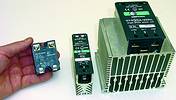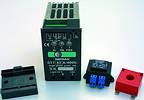

Solid-state switching devices are fast and wear-and-tear free. They only require a low energy control signal. Hence, they are increasingly used in favour of electromechanical switches (relays).
Solid-state switches now incorporate features that vastly simplify control and supervision. This opens new avenues for PC/PLC control and scada systems. Latest versions feature serial communication interface, internal current transformers, restorable electrical fuses and master-slave control. Consideration to heat dissipation and protection against excessive voltage and current greatly enhances the reliability of solid-state switches.
Traditionally, a distinction is made between solid-state relays (SSRs), which operate in on-off mode and thyristor drives which regulate the supply voltage proportional to an analog input signal. This line becomes blurred due to the introduction of burst-firing solid-state switches, which vary the output duty cycle in proportion to an analog input signal.

* Logic input solid-state relays: Logic control solid-state relays are used where frequent switching occurs. Typical applications are PID control of heating elements and solenoid valves. Zero crossover switching reduces interference on the power supply line. The control signal is usually a logic signal of 4 to 32 V d.c. Less expensive SSRs have an internal triac and are only suitable for resistive loads (AC1-rating), whereas solid-state relays with internal thyristors have an AC3 rating and are suitable for resistive and inductive loads (valves, solenoids...).
* Analog input solid-state relays: proportional (analog) input, burst firing control solid- state relays are used to control fast processes where a typical PID cycle time of 1 s is too slow. Zero crossover switching is maintained and proportional control is achieved by varying the duty cycle (ratio of on pulses to off-pulses). The control signal is usually 4-20 mA or 0-10 V d.c. Typical applications include long-to-medium wave infrared heating arrays and air heating systems that have a fast response time.
* Phase angle solid-state power controllers (thyristor drives): proportional (analog) input, phase angle control devices are used for processes where a smooth modulation of the power supply is required. Through phase angle control part of the sine wave is sliced off, resulting in power reduction. The control signal is typically 4-20 mA or 0-10 V d.c. Applications include short-to-medium wave infrared heating arrays, transformers, vibrators and speed control on fans.
* Three-phase switching: For three-phase applications either three-phase SSRs or three single phase SSRs can be used. Care should be taken that single phase SSRs are rated at 400 V or higher since the loss or absence of a neutral connection on an unbalanced (or faulty) load can place the full phase voltage across the switching device. Some manufacturers offer a master-slave connection that synchronises switching and reduces current pulsation on the neutral conductor.
* Protection: Solid-state devices are susceptible to overheating, overvoltage, high-voltage spikes and fault currents. Adequate heatsinks, proper ventilation, ultra-rapid fuses and transient arrestors (MOV, RC-circuit) are therefore essential considerations for installation of SSRs. Solid-state switching devices are most likely to fail in the on mode. Safety override (eg high temperature cut out) should therefore be considered to switch off the main contactor.
The recent acquisition of Coreci by Gefran has made a comprehensive range of solid-state switches available to the South African industry via local distributor Unitemp. Gefran offers advanced power control units up to 600 A with power soft-start, current limit, current feedback; electronic (resettable) fuse and RS485 interface with Modbus protocol. This allows multidrop remote control of power and offers various diagnostic functions including the ability to read line voltage and load currents.
Unitemp
(021) 762 8995

© Technews Publishing (Pty) Ltd | All Rights Reserved